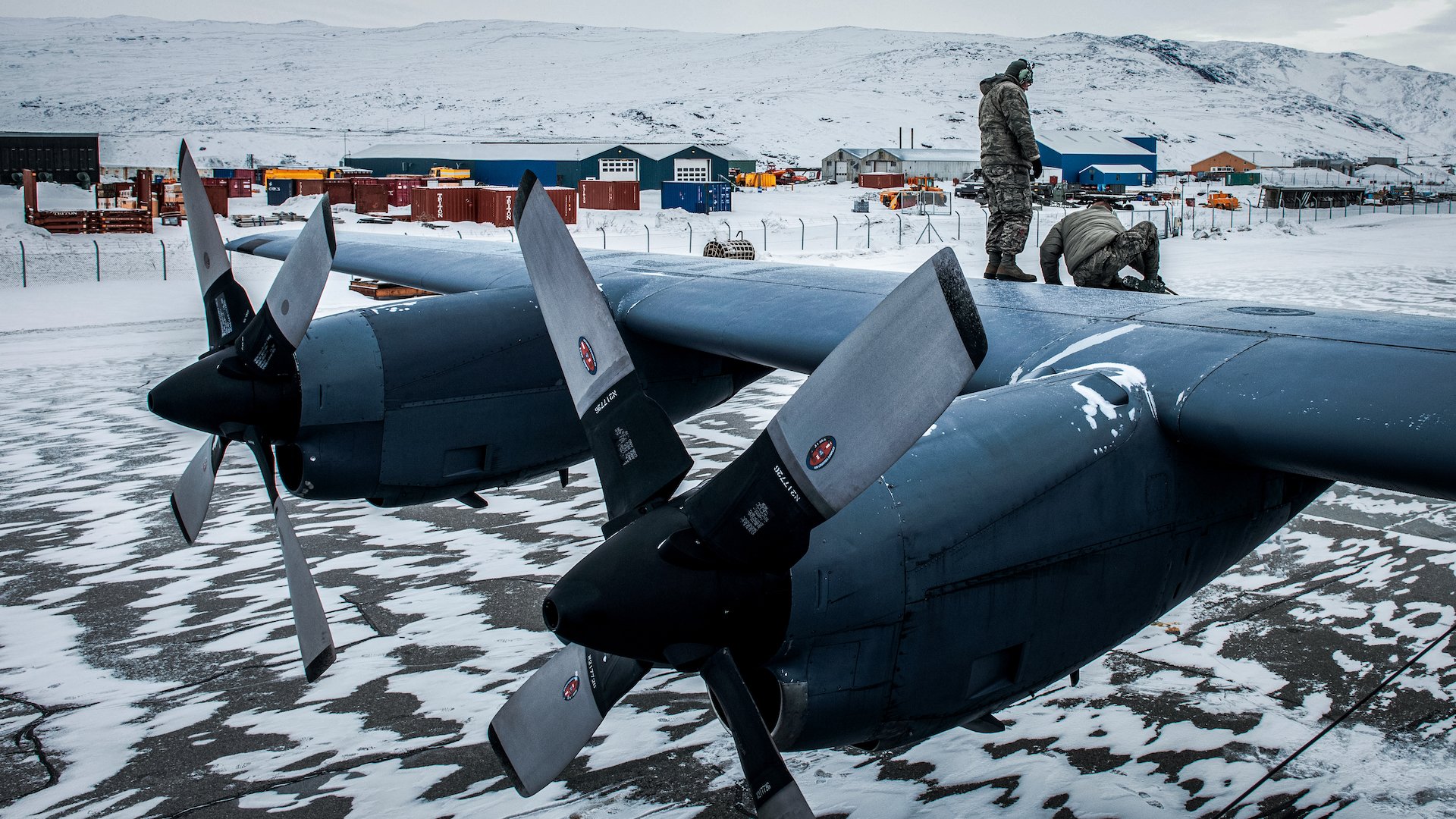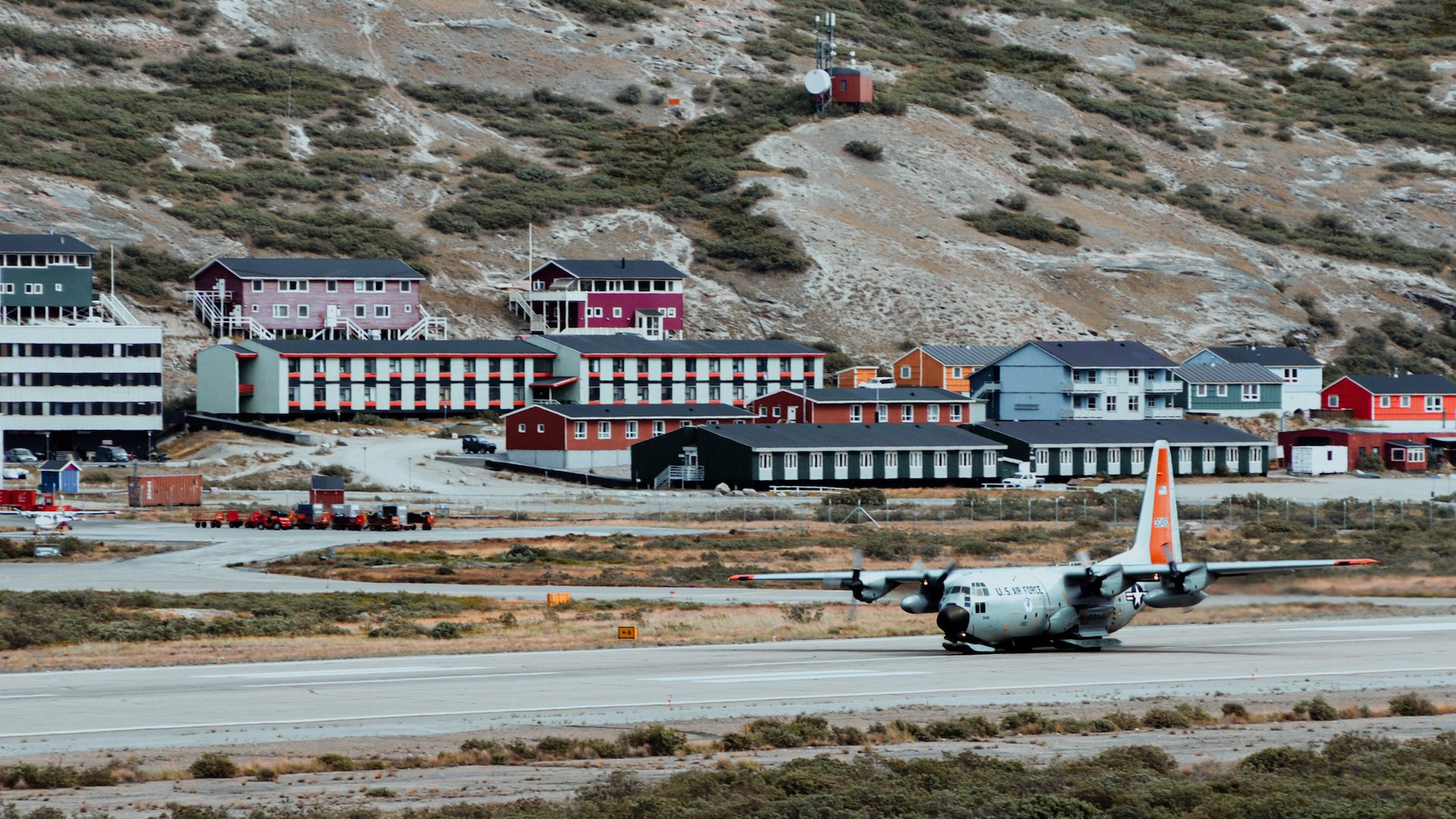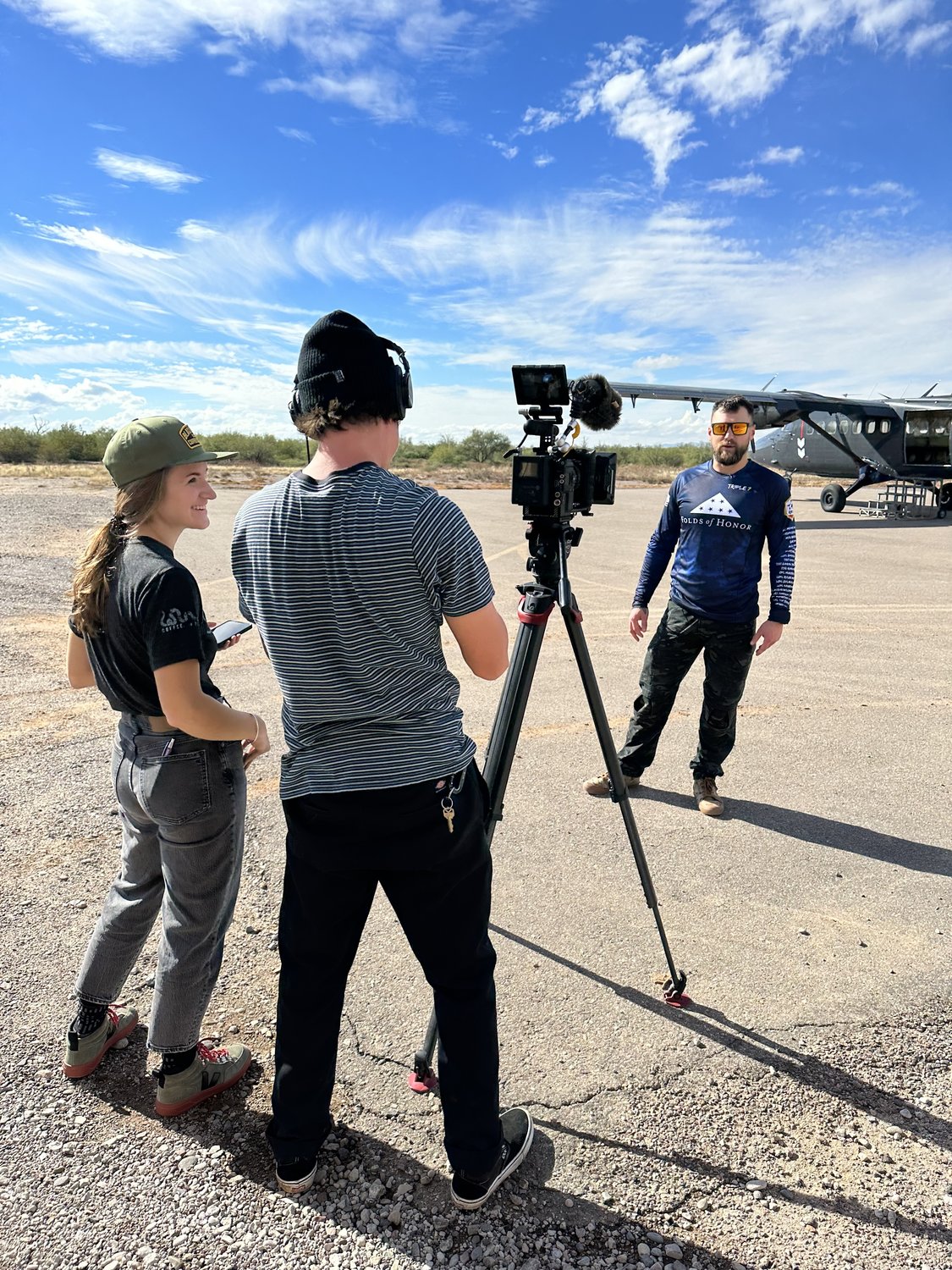
Service members from the 103rd Maintenance Squadron, Connecticut Air National Guard, inspect the wing of a C-130 on April 2, 2019, in Kangerlussuaq, Greenland. US Air National Guard photo by Tech. Sgt. Tamara R. Dabney.
This summer, you should vacation to the world’s largest island. No, not Australia — that’s a continent. I’m talking about not-so-green Greenland, the North Atlantic island that is part of the Kingdom of Denmark and three times the size of Texas. Forget your bathing suit and sunscreen, however, and instead pack a balaclava and parka. Two-thirds of the island country lies above the Arctic Circle, and 80% is covered in a flat, seemingly endless sheet of white — one of only two masses of more than 19,000 square miles of glacial ice worldwide. (Antarctica is home to the other.) If you go to Greenland and don’t walk on the ice, did you even go?
To get to Greenland’s ice cap, you’ll probably end up 30 miles north of the Arctic Circle in Kangerlussuaq, a southwestern settlement known as “the gateway to Greenland.” It boasts 500 residents, is the only town with road access to the ice, and is home to the island country’s main international airport (at least for now). As a result, Kangerlussuaq primarily exists to support the ebb and flow of travelers. But if you look closely — past the rickety, gumball-colored houses built in a “U” around the airstrip; the ’90s vehicles zooming around the curve, from one side to the other, like there is somewhere else to be; and the runway backed up with Christmas-red Air Greenland turboprops — you’ll see the familiar, utilitarian neutrals of US military aircraft resting on the flight line. Believe it or not, Kangerlussuaq is a military town with more than 80 years of history.

An LC-130 “Skibird” with the 109th Airlift Wing, New York Air National Guard, takes off from Kangerlussuaq, Greenland, on June 29, 2014, for Summit Camp, a research station on the island country’s nearly 700,000-square-mile ice cap. US Air National Guard photo by Staff Sgt. Benjamin German.
Kangerlussuaq Then
Situated on the banks of a glacier-carved fjord, Kangerlussuaq was founded in 1941 as the US air base Bluie West-8. The Army chose the area for an airstrip because the nearby cliffs protect against bad weather, making the spot ideal for planes to take off and land. For that reason, the military installation served as a stopover for aircraft en route to the European Theater during World War II.
After the war, Bluie West-8 was renamed Sondrestrom Air Base. For several decades, the base served as the springboard for resupply airlifts to Cold War radar sites on the ice cap. Even though Sondrestrom closed in 1992 after the Iron Curtain fell, the US military still lives on in Kangerlussuaq, though with a much smaller footprint. Every year, the New York Air National Guard’s 109th Airlift Wing summers in Kangerlussuaq, flying resupply missions from the town to remote research camps in Greenland. Kangerlussuaq also serves as the 109th’s jumping-off point for Arctic survival training on the ice.
Related: The US Military in Greenland, America’s Defense Bastion in the High North
Kangerlussuaq Now
Kangerlussuaq — Kanger, for short — isn’t your typical military town, but it is one all the same, complete with the relics and rituals. There are the husks of artillery, a museum repurposed from the base headquarters, and a snarky, old sign: “Sondrestrom is a nice place to live, by order of the base commander.” To this day, New York’s Guardsmen still sleep in dorms left over from past wars, and even Greenlanders inhabit US military history, smoking cigarettes only to put them out on empty rocket pods propped up around town.
And then there are the rituals. Rumor has it one pilot from the 109th dons his furs — a full-length coat and hat — every time he crosses the Arctic Circle. In something called a “Blue Nose” ceremony, veterans of the High North welcome newbies to the top of the world.
But perhaps eating hot dogs, called “Sondi Dogs” after Sondrestrom Air Base, is the 109th’s most beloved ritual of all.

An airman with the New York Air National Guard prepares to eat a beloved “Sondi Dog.” According to legend, not only is the hot dog machine a Cold War relic, but the Sondi Dogs very well may be, too. Photo by Ryan Fitting/Coffee or Die.
Day in and day out, grayish, slightly longer-than-usual franks steam away on the flight line in a retro hot dog machine. Crew members might scarf down one or two between flights to the ice — while mechanics seem to eat them all the time: before, during, and after repairs.
According to legend, not only is the machine a Cold War relic, but the Sondi Dogs very well may be, too. No one knows exactly when or how the picnic meat arrived in Kangerlussuaq, but the supply never ends, even though the demand is high. A wall plaque says one airman, Zach Lettko, ate a record 26 Sondi Dogs in one day. Plus, consumption is often mandatory. A flier reads: “ATTENTION: FLIGHT CREW MUST CONSUME A MINIMUM OF 1 HOT DOG EACH PER HOUR OF WEATHER DELAY.” That might read like punishment, but the Guardsmen actually seem to enjoy eating Sondi Dogs, or at least the bonding experience.
Though the larger US military left Kangerlussuaq decades ago, New York’s 109th Airlift Wing keeps 80-plus years of history alive by making more. So if you ever make it out to Greenland, be sure to visit the ice sheet, but also plan to spend extra time taking in some history at Kanger — and if you’re lucky, maybe a Sondi Dog, too.
Read Next: NY’s 109th Airlift Wing: Home of the LC-130, World’s Largest Skiplane

Jenna Biter is a staff writer at Coffee or Die Magazine. She has a master’s degree in national security and is a Russian language student. When she’s not writing, Jenna can be found reading classics, running, or learning new things, like the constellations in the night sky. Her husband is on active duty in the US military. Know a good story about national security or the military? Email Jenna.
BRCC and Bad Moon Print Press team up for an exclusive, limited-edition T-shirt design!
BRCC partners with Team Room Design for an exclusive T-shirt release!
Thirty Seconds Out has partnered with BRCC for an exclusive shirt design invoking the God of Winter.
Lucas O'Hara of Grizzly Forge has teamed up with BRCC for a badass, exclusive Shirt Club T-shirt design featuring his most popular knife and tiomahawk.
Coffee or Die sits down with one of the graphic designers behind Black Rifle Coffee's signature look and vibe.
Biden will award the Medal of Honor to a Vietnam War Army helicopter pilot who risked his life to save a reconnaissance team from almost certain death.
Ever wonder how much Jack Mandaville would f*ck sh*t up if he went back in time? The American Revolution didn't even see him coming.
A nearly 200-year-old West Point time capsule that at first appeared to yield little more than dust contains hidden treasure, the US Military Academy said.












